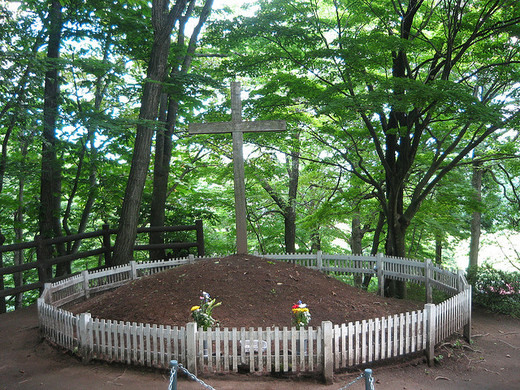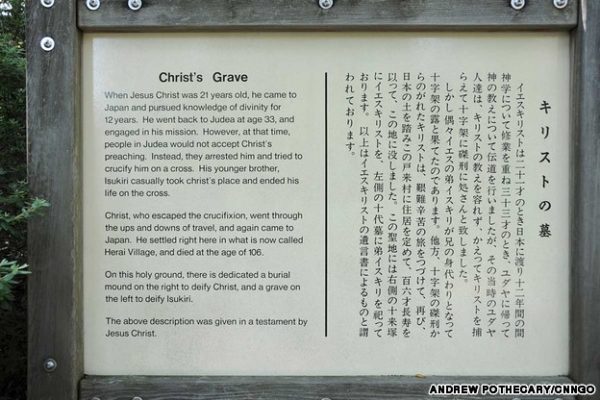
Twenty thousand people every year visit Shingō Village in the Aomori Prefecture (referred to as: Kirisuto no Sato or “Hometown of Christ” by locals) that claims that Jesus visited Japan during his lost years and then returned after escaping crucifixion by having his brother take his place on the cross, making his way to Shingō where he became a garlic farmer, married a local woman, and had three children.
Today, in Shingō, you can visit Jesus’ alleged grave site and museum. Next to Jesus’ mound is another mound where Jesus’ brother’s ear is buried along with a lock of hair from Mary—both of which, according to the legend, he carried with him when he fled execution.

Just in case that’s hard to read:
When Jesus Christ was 21 years old, he came to Japan and pursued knowledge of divinity for 12 years. He went back to Judea at age 33 and engaged in his mission. However, at that time, people in Judea would not accept Christ’s preaching. Instead, they arrested him and tried to crucify him on a cross. His younger brother, Isukiri casually took Christ’s place and ended his life on the cross.
Christ, who escaped the crucifixion, went through the ups and downs of travel, and again came to Japan. He settled right here in what is now called Herai Village, and died at the age of 106.
On this holy ground, there is dedicated a burial mound on the right to deify Christ, and a grave on the left to deify Isukiri.
The above description was given in a testament by Jesus Christ.
Sound ridiculous? That’s because it is. Especially when you consider the fact that only one percent of people in Japan identify as Christian. But let’s pretend for a moment that there is something actually to this whole thing. How do people know Jesus visited Japan and then later died there? According to the legend, in 1935, Jesus’ last will and testament was found, which proved that he had not only been in Japan but died there. The document was “coincidentally” burned during World War II, but “luckily” someone had made copies.
What’s the proof that Jesus was actually in Shingō? Here is the “evidence” that is often cited:
It has been pointed out that some of the traditional clothing of the region included toga-like robes worn by men that were unlike other Japanese clothing, as well as veils worn by women, all of which seem more like something from biblical Palestine than Japan. In addition, some of the ancient traditions of the area included other things that are considered to be decidedly non-Japanese, such as carrying babies in woven baskets, wrapping them in robes embroidered with something akin to the Star of David, and marking their foreheads with crosses of charcoal. Even the regional dialect is said to have connections to the Holy Land, with some words resembling Hebrew more than Japanese. Even the name of the village itself was once Herai, which is remarkably similar to the Japanese word for Hebrew, Heburai. On top of all of this, it was once said that many of the villagers had decidedly foreign looking facial features and even blue eyes- let’s ignore that Jesus most certainly did not have blue eyes- that were seen to be a sign that they were descended from someone of non-Japanese origin. (Source)
My favorite part of the myth is Jesus’ supposed decedents have not let the fact that they are related to arguably the most important person to ever walk our planet get to their heads. In fact, a reporter asked one of them if they were going to do anything for Christmas and this was their answer:
“I’m not really planning anything at all for the 25th as it doesn’t really matter to us,” said 52-year-old Mr Sawaguchi. “I know I am descended from Jesus but as a Buddhist it’s just not all that important.” (Source)
Thankfully, it appears that most people in the village don’t actually believe any of this. They seem to mostly want to play along because it brings tourists—from I imagine all over the world—to a small village no one would visit otherwise and spend money at the museum gift shop.
“We’re not saying that the story is true or what is written in the Bible is wrong,” a village official told the BBC. “All we are saying is that this is a very interesting old legend. It’s up to the people who come here to decide how they interpret it.” (Source)
Are you interested in visiting Kirisuto no Sato? It’s apparently quite a commute from Tokyo. For specifics, check out CNN’s Travel article.
What do you think? Any chance Jesus didn’t die on the cross and ended up in Japan as a garlic farmer instead?
- Excited
- Fascinated
- Amused
- Disgusted
- Sad
- Angry








